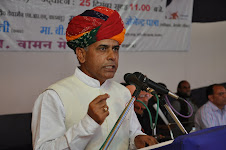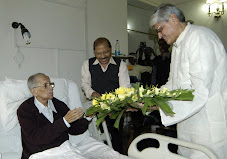Women Lead Resistance
Monday, April 9, 2007
Palash BiswasBoth feminism and nationalism in India emerged from the social reform movement of the C19th, it is widely believed. But fact is that tribal women enjoyed equality from the beginning and it is not the feminism advocted by the Ruling Brahmins in India. Even before Renaissance, Dalit Women of Bengal had the awakening as they were directly involved with the production system!
Women of Nandigram fought and led the fight from Front as they happen to be associated with indegineus production system. We may remember the fight of Mother India, fight of Dhania in `Godan, if we like.
The social reform movement originated within the Indian intelligentsia and spread to sections of the middle classes. But the peasant women were socially much more conscious from the beginning.
Mind you, Midnapur happens to be the Home of Matangini Hazra!
During the quit india movement, the people of Medinipur planned an attack to capture the Thana, court and other government offices. Matangini, who was then 72 years old, led the procession. The police opened fire. A bullet hit her arm. Undaunted she went on appealing to the police not to shoot at their own brethren. Another bullet pierced her forehead. She fell down dead, a symbol of the anti-colonial movement, holding the flag of freedom in her hand.
What Nandigram has seen, hence, it is nothing new for Bengal!
In fact, Indian Women have come in front to lead the Great Indian Resistance against Post Modern manusmriti, Neo Libetral Globalisation in form of eviction of the masses from the roots!
It is not only coincidence that Brahminical Hindutva considers all Women SHUDRA! Islam also says that women are unsacred! Varnshram never helped women!
Because all women are shudra, the women Mahashweta devi, Medha Patkar, Arundhati Ray, Aparna Sen, Nabaneeta Dev sen, Shaonli Mitra, Anuradha Talwar, Joya Mitra and all women from Singur and Nandigram shows us well how to Resist State Power!
We have seen it often in Manipur!
These ladies deny to be show piece fair commodity meant for the open market!
As Nandigram in West Bengal became a lightning rod for criticism of economic reforms, candidates in Dadri, home to more than 200 villages, are wooing farmers with a promise that they will not allow the forcible acquisition of land to set up industries or plush residential enclaves.
Farmers to whom the lands belong complain that they have been caught unaware by the acquisition process.
Political parties, including the Bharatiya Janata Party, Bahujan Samaj Party and former prime minister V P Singh's Jan Morcha, have demanded that the Samajwadi Party government make the entire land acquisition process transparent so that the farmers' right to just compensation is not affected.
"The compensation awarded to farmers is nowhere near the market price of land. There is no transparent move to uphold in full the rights of those who have been displaced because of this land acquisition," BJP legislator Nawab Singh Nagar, seeking to retain his seat on the same plank, said as he walked into a dusty village of the constituency for his campaign.
Last year, V P Singh and Communist Party of India general secretary A B Bardhan were arrested by police as they headed to Dadri for a protest against alleged inadequate compensation to villagers whose land was acquired for a mega power project of Reliance.
"There have been similar protests and demonstrations in Dadri since Noida and Greater Noida came into being. But farmers continue to suffer. Nobody is genuinely concerned about their welfare," said Congress candidate Raghuraj Singh.
Hazra, Matangini (1870-1942) a famous Gandhian leader and a humanitarian. Matangini Hazra (Matangini Hazra) was born at a village named Hogla under Tamluk Thana of Medinipur in West Bengal. Daughter of a poor peasant, she had no access to education at her father's house. Given in marriage at an early age, Matangini became widowed at eighteen without having any children. She played an active role in the struggle for independence from colonial rule and followed Mahatma Gandhi's creed of non-violence.
In 1932, Matangini participated in Gandhi's civil disobedience movement (Salt Satyagraha), manufactured salt at Alinan salt centre and was arrested for violating the salt act. After her arrest she was made to walk a long distance as punishment. She also participated in the 'Chowkidari Tax Bandha' (abolition of chowkidari tax) movement and while marching towards the court building chanting slogan to protest against the illegal constitution of a court by the governor to punish those who participated in the movement, Matangini was arrested again. She was sentenced to six months imprisonment and sent to Baharampur jail.
After her release Matangini got actively involved with the activities of the indian national congress. She took to spinning thread and Khaddar (coarse cloth) like a true follower of Gandhi. In 1933 she joined the 'Mahakuma Congress Conference' at serampore where police resorted to baton charge on the protesters. Always engaged in humanitarian causes, she worked among affected men, women and children when small pox in epidemic form broke out in the region. People lovingly called her 'Gandhi Buri'.
The Left Front's most recent record in ushering in capitalism in the state of West Bengal is shameful, but there isn't even a muted response to the Pakistan judiciary reeling under the boots of a military dictator.
However, let's stick to India alone. Even though the Left allows the UPA government to survive on its oxygen, it misses no opportunity to bare the Manmohan Singh government's capitalists tendencies. And in its own bastions of West Bengal and Kerala, it's not just rolling out red carpet to woo foreign investment but is shameless in suppressing popular revolt.
The contradictions are clear. Coming from the CPI(M), lofty ideas, talks of power to the people and human rights appear hollow. The emperor has no clothes. Scores of artists and intellectuals across the country have showed their resentment in no uncertain terms.
Also, West Bengal Governor Gopal Krishna Gandhi has hardly ever courted political controversy. He is known to be a man of scholarship, integrity and composure. When he criticises the government, it contains the credulity of honesty.
The state government thought it would get away this time, too. It thought that a nexus of party, police and a highly politicised establishment would again suppress opposition. It forgot, however, that communication technology and a vibrant media not only had gathered more strength in recent times but also spread the reach. Mamata Banerjee just fitted the bill.
The support of Jamiat-e-Ulema against the state government is again reflective of the withering away of its Muslim vote bank. So, did Nandigram happen due to CPI (M)'s overconfidence? Partly. More so, due to the bourgeois attitude that has crept into the leadership.
Nandigram, quite naturally, generated much political heat in both the Houses. The NDA and the ruling almost came to blows. It was only expected. But the sheer ruffian behaviour of the Kolkattan Left forced Speaker Somnath Chatterjee to offer his resignation for the nth time. No, the Communists did not attack any member from the Opposition benches but a Cabinet minister belonging to DMK, a fellow ally in UPA.
In accordance with written history, Faminism appeared first in Bengal - Ram Mohan Roy founded Atmiya Sabha in Bengal in 1815. 1828 Brahmo Samaj also formed in Bengal.It was partly inspired by Hindu revivalism and partly by liberal ideas.
Talwar (1990) points out that the movement for the uplift of women initiated by men in the early C19th – e.g. Raja Ram Mohun Roy – and included education, widow remarriage, abolition of purdah, and agitation against child marriage.
The author argues that social reform movements arose out of conflict between the older feudal joint family system and material needs of the developing urban middle class.
The urban m/c family was no longer a productive unit but a place of emotional fulfilment. The reform movement of the C19th was generally limited to urban areas.
'As an Indian bourgeois society developed under western domination, this class sought to reform itself, initiating campaigns against caste, polytheissm, idolatry, animism, purdah, child marriage, sati and more, seeing them as elements of a pre-modern or primitive identity' (Kumar 1993).





































No comments:
Post a Comment